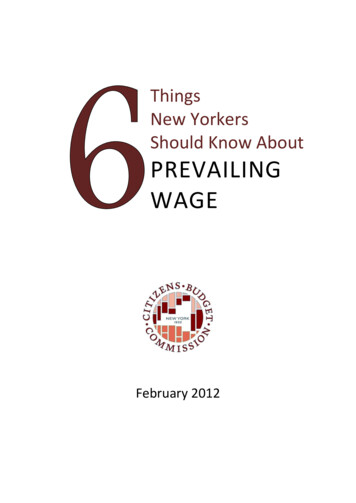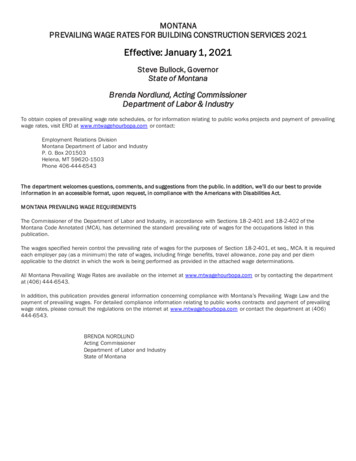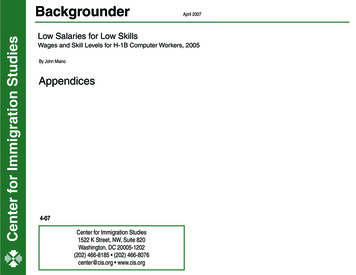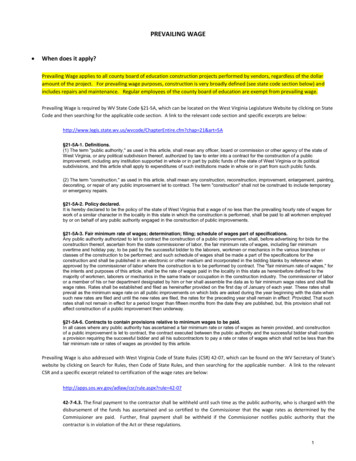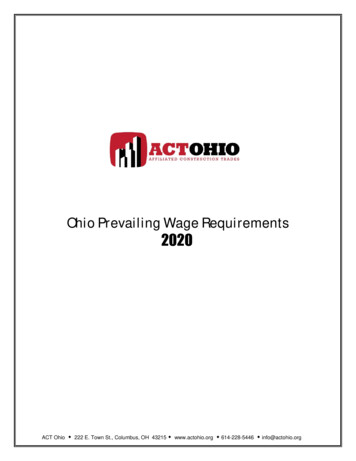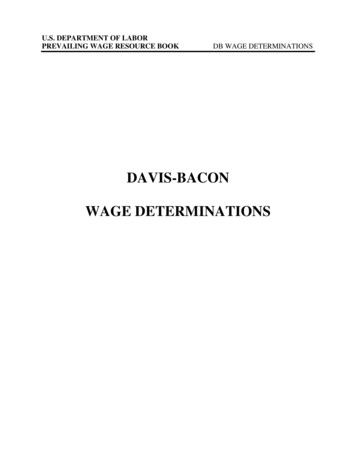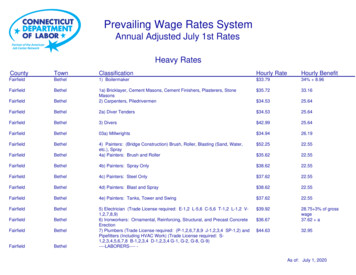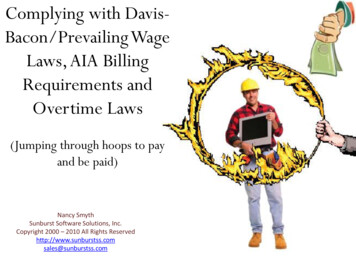
Transcription
Kansas and Prevailing WageLegislationBy Peter Philips, Ph.D.Professor of Economics, University of UtahPrepared for the Kansas Senate Labor and Industries Committee, February 20, 1998
Table of ContentsList of Tables and FiguresAbout the AuthorExecutive SummaryChapter One:History of Prevailing Wage Regulations in Kansas and the U.S.Chapter Two:A Case Study of the Effect of Prevailing Wage Repeal on Costs: theCost of School Construction in Kansas and Surrounding Great PlainsStatesChapter Three:Loss of Construction Worker Income Due to RepealChapter Four:Loss of Apprenticeship Training in Kansas Due to RepealChapter Five:Increase in Job-Site Injuries in Kansas Due to RepealChapter Six:Loss of Pension and Health Insurance Coverage in Kansas Due toRepealChapter Seven:Summary and Conclusion1
List of Maps, Tables and FiguresMap: Legal Status of Prevailing Wage Law in Kansas and 14 GreatPlains Comparison StatesTable 1: Square Foot Construction Costs of Public and PrivateElementary Schools by 15 States and Legal StatusTable 2: A Comparison of Average Square Foot Cost of A NewElementary School in Great Plains States with and without a PrevailingWage LawTable 3: Square Foot Construction Costs of Public and Private MiddleSchools by 15 States and Legal StatusTable 4: A Comparison of Average Square Foot Cost of A New MiddleSchool in Great Plains States with and without a Prevailing Wage LawTable 5: Square Foot Construction Costs of Public and Private HighSchools by 15 States and Legal StatusTable 6: A Comparison of Average Square Foot Cost of A New HighSchool in Great Plains States with and without a Prevailing Wage LawTable 7: Wages as a Percent of School Construction Cost and AverageWage Rate in School Construction by Region of the U.S.Table 8: Distribution of Apprenticeship Training Under CollectiveBargaining and in the Merit Shop, in Kansas, Total and by CraftTable 9: Number of Construction Apprentices by State and Year forKansas and 14 Great Plains Comparison States by Legal Status ofPrevailing Wage LawTable 10: Number of Minority Construction Apprentices by State andYear for Kansas and 14 Great Plains Comparison States by LegalStatus of Prevailing Wage Law2
Table 11: Number of Female Construction Apprentices by State andYear for Kansas and 14 Great Plains Comparison States by LegalStatus of Prevailing Wage LawTable 12: Average Annual Injury Rates in Construction in Kansas Beforeand After the Repeal of Kansas' Prevailing Wage LawTable 13: Average Annual Injury Rates in Construction in Kansas and14 Comparison Great Plains by Legal Status of Prevailing Wage LawTable 14: Annual Average Per Worker Employer Contributions toPensions and Health Insurance in Kansas and the Percent of WorkersInsured by Merit Shop ContractorsFigure 1: Labor Costs Including Benefits as a Percent of Total Costs inKansas, 1977 to 1992Figure 2: Annual Wage Income of Construction Workers in Five GreatPlains States without Prevailing Wage Laws Compared to Ten GreatPlains States with Prevailing Wage LawsFigure 3: Wage Costs as a Percent of Total Costs in Five Great PlainsStates without Prevailing Wage Laws Compared to Ten Great PlainsStates with Prevailing Wage LawsFigure 4: Average Wage Income of Kansas Construction WorkersCompared to the Wages of Construction Workers in Four Great PlainsStates with No Prevailing Wage Law and Ten Great Plains States withPrevailing Wage Laws Before and After the Kansas RepealFigure 5: Annual Number of Injuries per Construction Worker in KansasBefore and After the Repeal of Kansas' Prevailing Wage LawFigure 6: Annual Number of Serious Injuries per Construction Worker inKansas Before and After the Repeal of Kansas' Prevailing Wage LawFigure 7: Total Annual Average Employer Contribution to Pension andHealth Insurance in Kansas Prior to and After Repeal of Kansas'Prevailing Wage Law3
About the AuthorPeter Philips grew up in Compton and Pomona, California. He receivedhis B.A. from Pomona College in 1970 where received the LelandBackstrand Graduating Senior Award in Economics. Philips received hisMA. (1976) and his Ph.D. (1980) from Stanford University. Philips is aProfessor of Economics at the University of Utah. He is co-editor ofThree Worlds of Labor Economics (M.E. Sharpe, 1986) and co-author ofPortable Pensions for Casual Labor Markets (Quorum Books, 1995).Philips has published widely on the canning and construction industriesin journals such as Industrial and Labor Relations Review, IndustrialRelations, Business History, the Journal of Economic History, TheJournal of Economic Literature and the Cambridge Journal ofEconomics. Philips has been a consultant for the U.S. Labor Departmentanalyzing the supply of cannery labor in California, and he has worked asan expert on the Davis-Bacon Act for the U.S. Justice Department. TheDavis-Bacon Act regulates wage payments to construction workers onfederal public works. Philips is a respected expert on prevailing wagelaws and on employment, training wages and benefits in the constructionindustry. He has testified before state legislative committees in Ohio,Indiana, Oklahoma, New Mexico and California on their state prevailingwage laws. Along with other researchers at the University of Utah,Philips has analyzed the effects of prevailing wage laws on publicconstruction costs, construction worker incomes, apprenticeship training,worker safety and minority access to construction work.Philips has received awards for his teaching and community service,including the University of Utah Lowell Bennion Public ServiceProfessorship, the University of Utah Presidential Teaching ScholarAward and the University of Utah, College of Social and BehaviorScience Superior Teacher Award. Philips is married with two children.4
AExecutive SummaryLegal Statusof Prevailing Wage LawRepealed 1985 & 87(2)Judicially Annulled 1995(1)Never Had Law(3)Has Law(9)15 State ComparisonA 15 Great Plains state comparison shows that afterKansas repealed its prevailing wage law in 1987 Wage incomes in Kansas construction fell by 10% not juston public works but across all construction. Employer pension and health insurance contributions fell by17%. While almost all construction workers covered by collectivebargaining in Kansas receive health insurance andemployer pension contributions, only 10% of the workers in5
the open (or merit) shop receive pension coverage and only4% receive health insurance from their employer. Apprenticeship training in Kansas construction fell by 38%after repeal. Minority apprenticeship training in Kansas fellby 54%. This was due to a shift away from collective bargainingtowards open shop (or merit) shop construction. Merit shopcontractors account for only 12% of all apprentices beingtrained in Kansas. As the merit shop share of the marketgrew after repeal, apprenticeship training fell substantially. With lower wages and benefits and less training, a new,younger, less-skilled, less-experienced work force enteredKansas construction. Serious-injury rates in Kansasconstruction rose by 21% after repeal of the state prevailingwage law. While the pain of repeal is real and measurable, theprojected gain from repeal--a 6% to 17% savings on stateconstruction costs--failed to materialize. Elementary school, middle school and high school newconstruction costs are virtually identical between GreatPlains states with and without prevailing wage laws.6
Overview. Kansas prevailing wage law--the first in the country--waspassed in 1891 to help prod the Kansas labor market in general and theconstruction labor market in particular down a high-skilled, high-wagegrowth path. Confronted with falling wage rates and longer working days,the Republican government of Kansas embraced a series of reformsincluding child labor laws, compulsory schooling, convict labor laws, theeight-hour day and prevailing wages. All of these reforms were aimed atthe same goal. The Kansas labor market was to be regulated so thatyoung people were in school, apprenticeships would be encouraged, theworking day would be limited, and competition would be built upon asystem of skill-formation that generated and justified rising wages andincomes. Kansas legislators did not want businesses to prove profitablesimply because people were working longer for less, and younger withless skills.Almost 100 years after its original passage, Kansas' prevailing wage lawwas repealed on the promise that Kansas taxpayers would save from 6%to 17% on total construction costs depending on the project---and in somecases the savings would be even higher. To obtain these gains, workerswages on public works would have to be cut. If there were spill-overeffects on wages outside public works, that would be the additional cost ofsaving money on public construction.The immediate effect of the repeal of Kansas' prevailing wage law wasthat construction wages were cut--not only on public construction--butacross the entire Kansas construction labor market. Adjusted for inflation,Kansas construction workers wage incomes fell by 11% from 1987, theyear of the repeal to 1991. This amounted to a drop in average wagesfrom 25,573 to 22,807. In the nine Great Plains states surroundingKansas that retained their prevailing wage laws, wage income fell--butonly by 2%. So the predicted pain of prevailing wage repeal had beenachieved. Was there a corresponding gain for that pain? Were stateconstruction costs cut by from 6% to 17% or even higher?A case-study comparison of new school construction costs in Kansascompared to surrounding Great Plains states that have retained theirprevailing wage laws finds no difference in square foot construction costs.The average square foot construction cost of building 365 elementaryschools in nine Great Plains states with prevailing wage laws was 76.86.The average square foot construction costs of building 81 new elementaryschools in six Great Plains states--including Kansas--that do not haveprevailing wage laws was 76.23. Comparison of the square foot costs ofmiddle schools and high schools yielded similar results. There is nostatistically significant difference in school construction costs betweencomparable states with and without prevailing wage laws.7
Why could wages be cut substantially and yet, no construction savingswere forthcoming? The answer is--training and productivity fell with wagerates. Apprenticeship training in Kansas fell by 38% after the staterepealed its prevailing wage law. Minority apprentices fell even more by56% after the repeal of the Kansas law. The balance of constructionshifted away from collective bargaining towards the open shop. Currently,open shop contractors account for only 12% of all enrolled apprentices inKansas. Thus, as the unions declined, the open shop did not take up theslack in apprenticeship training. Rather, in the short-run, merit shopcontractors hired union-trained journeymen at substantially lower wagerates and markedly reduced pension and health programs. Totalemployer contributions to pension and health insurance in Kansas fell by17% after the state repealed its prevailing wage law. This was a drop froman annual average of 20 million per year to 16.6 million. This drop wasdue to a shift from collective bargaining to the merit shop. Almost all unioncontractors in Kansas provide pension coverage and health insurance.Currently, only 10% of merit shop workers in Kansas are covered by acompany pension and only 4% receive company health insurance.With lower wages and benefits, experienced and skilled workerseventually migrated out of the industry or retired. With a 38% fall-off inapprenticeship training, skilled and experienced older workers werereplaced by younger, less-experienced, less trained workers. Thus, thepromised construction savings were based on a false premise--that wagerates could be cut without effecting productivity, and collective bargainingcould be terminated without effecting training. Both these premisesproved false.In place of lower construction costs, Kansas reaped a costly, higher injuryrate in construction. Less trained, younger, inexperienced and poorly paidworkers got hurt on the job much more often. In the five years afterrepeal, serious-injury rates in Kansas construction rose by 21% comparedto prior to repeal. A comparison of Great Plains states with prevailingwage laws compared to those like Kansas shows that states withoutprevailing wage laws have a 26% higher injury rate in construction.8
1The History of Prevailing Wage Regulationsin Kansas and the U.S.In February 1891, Samuel Gompers, president of the AmericanFederation of Labor, visited Topeka, Kansas, to speak on what the localnewspaper called "the great topic of labor." Ten years earlier, the AFL —at its own creation — had laid out legislative aims that included the eighthour work day, the elimination of child labor, free public schooling,compulsory schooling laws, the elimination of convict labor, and prevailingwages on public works. These proposals were based on a belief that theAmerican labor market should consist of highly skilled workers earningdecent wages, with time for family, and with children free to earn aneducation. In pursuit of these aims, Gompers' political strategy in Kansasallied him with the Republican Party.On the morning of Gompers' arrival, the Alliance Party, known to history asthe Populist Party, withdrew an earlier invitation for him to speak in the hallof the state House of Representatives, which the party controlled.Gompers, who represented 900,000 workers, had fallen out of favor withthe Populists, reportedly because of his belief that the trade unions shouldnot form a political party with the Alliance.1 Gompers and the AFL took theposition that unions should be nonpartisan. Rather than form a laborparty, Gompers advocated that unions support those of any party whowould support the needs of working men and women. In Kansas in 1891,this made Samuel Gompers an ally of the Republican Party. TheRepublicans, who controlled the Kansas Senate, invited Gompers tospeak there, and he did.Gompers was in Kansas to focus on the eight-hour day. Like otherAmericans, Kansans in 1891 typically worked six days per week, ten totwelve hours per day. In the older trades and crafts, such as carriage1. Topeka State Journal, February 24, 1891, col.4, p. 4.9
making and saddle making, where the work pace was slow and under theworkers' direction, the long work-day was tolerable. In the newer factoriesproducing shoes, textiles, and the like; in the mines; and in the urbanputting-out systems in needlework, six-day weeks and twelve-hour dayswere grueling. The AFL had made its prime objective a shortened workday and work week with as little cut in pay as possible. In his Topekaspeech, Gompers declared:Our banner floats high to the breeze and on that banner float isinscribed, "Eight hours work, eight hours rest and eight hoursfor mental and moral improvement." 2At that time, when there were no income supplement programs for thepoor, low-income parents worked and had to send their children to work tomake ends meet. This practice was later referred to by a North Carolinanewspaper editor as "eating the seed corn." Each generation of poorcondemned its offspring to poverty because the children grew up asilliterate as their parents. The prevalence of cheap child labor, whichaccounted for 5 percent of the manufacturing labor force in 1890 and alarger proportion of service sector workers, kept wages down and forcedadult workers to put in the long hours to make ends meet. Gomperswanted regulation to force employers and the poor to adopt a strategy,however painful in the short run, of a high-wage, high-skilled growth pathwhere children were in school and workers had the skills to justify wagesthat would allow for a family life. Gompers said,The Federation endorses the total abolition of child labor under14 years of age; an eight hour law for all laborers andmechanics employed by the government directly throughcontractors engaged on public work, and its rigid enforcement;protection of life and limb of workmen employed in factories,shops and mines; .the extension of suffrage as well as equalwork for equal pay to women.The Federation favorsmeasures, not parties.3Gompers also pleaded for workers to be paid the "current" daily wage sothey could afford the reduced work time. Government was being asked toset a good example for the private sector, to show that a refreshed laborforce could produce in eight hours what a fatigued and bedraggled laborforce turned out in ten or twelve hours. The prevailing wage law in its2. Topeka Daily Capital, February 25, 1891, p.1.3. Topeka State Journal, February 25, 1891, col. 3-4, p.1.10
infancy was an attempt to obtain shorter working hours for all labor. TheAFL paid attention to public works, however, because government at alllevels was a major purchaser of construction. The AFL said governmentshould not try to save money by eroding the wages of its citizens.With similar logic, the AFL called for an end to convict labor. Many statesemployed convicts to pay for their keep. Convicts built roads on chaingangs, operated farms, made textiles, and sewed garments. Convictmade goods were sold, forcing down prices and the wages of working freecitizens.In February 1891, the Second Annual Convention of the Kansas StateFederation of Labor, in Topeka, approved a bill concerning state-paidwages. That month, the bill, which included the prevailing wage section,called "for an Eight Hour Law" and was brought forth by Mr. Avery of theTypographical Union No.121, Topeka. The bill stated,That in no case shall any officer, board, or commission, doing orperforming any service or furnishing any supplies to the State ofKansas under the provisions of the act be allowed to reduce thedaily wages paid to employees engaged with him (or them) inperforming such service or furnishing such supplies, on accountof the reduction of hours provided for in the act. That in allcases such daily wages shall remain at the minimum rate whichwas in such cases paid and received prior to the passage of theact.4The eight-hour bill was one of four labor-related bills pending in the legislature:the weekly pay bill, the child-labor bill, and the bill to make the first Monday inSeptember a holiday, which would become known as Labor Day. In addition,that year the Kansas State Federation of Labor approved a resolution calling"for the abolition of convict labor when in competition with free labor." 5The eight-hour bill, Senate Bill 151, failed in the Kansas senate March 6,1891, with the prevailing wage section removed. But by March 10, when theprevailing wage section was put back in, the bill became law. This firstprevailing wage law stated:That not less than the current rate of per diem wages in thelocality where the work is performed shall be paid to laborers,4. Sixth Annual, 215.5. Sixth Annual, 124.11
workmen, mechanics and other persons so employed by or onbehalf of the state of Kansas.6We do not know the immediate impact of the Kansas prevailing wage law.But a report from the Oklahoma labor commissioner in 1910 may well haveapplied to Kansas. The Oklahoma law which was patterned after the Kansasact. It was passed in 1908. It was reported to have had the intended effectof setting wage and hour standards not only on public works but in relatedlabor markets. The Oklahoma Commissioner of Labor stated in 1910:The eight hour law has been of inestimable value to the laboring menof this state.The common laborer, who was heretofore employed tenand twelve hours per day, is now, under the provisions of this bill,allowed to work but eight hours.The law has not only affected thelaborers and those who are dependent upon this class of work for aliving, but it has gone further, and in many localities has gradually forcerailroad companies, private contractors [i.e. private construction] andpeople of that class to pay a high rate of wages for unskilled labor.7Some people have argued that the historic reason prevailing wage laws werepassed was to exclude African Americans from construction job sites.Prevailing wage laws have been described by some as Jim Crow laws. Thisis a difficult case to make for Kansas. The Kansas law was examined by theU.S. Supreme Court in Ashby v. Kansas. The Supreme Court Justice whowrote the deciding opinion upholding the constitutionality of the Kansasprevailing wage law was Justice John Marshall Harlan. Harlan wrote:When the eight hour law was passed the legislature had underconsideration the general subject of the length of a day's labor,6. L. 1891 Ch. 114 p.192-193.7Chas. L Daugherty, Labor Commissioner, Oklahoma Department of Labor, Third AnnualReport, Oklahoma City, OK, 1910, p. 327. The primary concern in both Kansas and Oklahomawas to use public works hours and wage policies to set and improve local labor standards. Atypical enforcement case in Oklahoma as reported by the Labor Commissioner follows:[Anadarko. May 10. 1908] We were advised that the O'Neill Construction Company had cut thewages on public works at Anadarko from twenty-five cents to seventeen and one-half cents perhour.[C]ontract was taken with the understanding that twenty-five cents per hour should be paid.The work was not progressing as rapidly as necessary to the cost within the estimate, hence thecontractors tried to take advantage of the situation by reducing pay. After thoroughly discussing thematter before the [city] council and contractor, the wages were restored to twenty-five cents. (p. 320)Second Annual Report Oklahoma Labor CommissionerChas. L Daugherty, Oklahoma City, OK, August 7, 1909.12
without specific reference to the purpose or occasion of theiremployment. The leading idea clearly was to limit the hours of toil oflaborers, workmen, mechanics and other persons in like employmentto eight hours, without reduction in compensation for the day'sservice.8John Marshall Harlan, Supreme Court JusticeHarlan's opinion about the purpose of Kansas' law is especially interestingtelling in light of the largely unsupported proposition that these laws were JimCrow laws. Justice Harlan is known to history as the single Supreme CourtJustice who spoke out against Jim Crow. In his famous dissent against theseparate but equal doctrine that legitimized racial segregation in the case of ?in 189?, Harlan argue vigorously for equal treatment of the races. If theKansas law had been a Jim Crow law in intent or effect, Justice Harlan wouldhave been the first to declare it so and argue against its existence.Those who have argued that prevailing wage laws are Jim Crow laws typicallypoint to one incident associated with the passage of the federal prevailingwage law in 1931, the Davis Bacon Act. Republican Representative RobertBacon complained of an Alabama contractor who came to his New Yorkdistrict in 1926 to build a federal veterans hospital. Rep. Bacon complainedthat the Alabama contractor was undercutting local wages and hours of workby importing cheaper southern labor. Critics of the Davis-Bacon Act haveassumed that Rep. Bacon was aiming his complaint at black labor. But in factRep. Bacon had indicated that the Alabama contractor had brought up amixed crew of both black and white workers. Indeed, at the time, two-thirds ofall Alabama construction workers were white. While the hod carriers andlaborers were likely to have been blacks from Alabama, the brick masons andcarpenters were likely to have been white. The notion that Rep. Bacon wasaiming his legislation as a Jim Crow attack on southern blacks is thinlysupported speculation.Republican Representative Fiorelo LaGuardia was familiar with this particularAlabama contractor. He mentioned this issue as he argued for the passage ofthe Davis Bacon Act in 1931. He argued on the floor of the House:A contractor from Alabama was awarded the contract for the NorthportHospital, a Veterans’ Bureau hospital. I saw with my own eyes thelabor that he imported there from the South and the conditions underwhich they were working. These unfortunate men were huddled inshacks living under most wretched conditions and being paid wagesfar below the standard. These unfortunate men were being exploited8Quoted in: Oklahoma, Department of Labor, Second Annual Report, Oklahoma City, OK,1909, p. 327.13
by the contractor. Local skilled and unskilled labor were not employed.The workmanship of the cheap imported labor was of course veryinferior.all that this bill does, gentlemen, is to protect the Government,as well as the workers, in carrying out the policy of paying decentAmerican wages to workers on Government contracts. [Applause.]9Prevailing wage laws were Republican legislation. The Davis Bacon Act wasnamed after a Republican representative from New York and a RepublicanSenator from Pennsylvania. The Davis Bacon Act was signed by RepublicanPresident Herbert Hoover.The rationale for prevailing wage laws is rooted in a philosophy of economicgrowth. Prevailing wage laws support higher wage rates and greaterunionization in construction. The absence of prevailing wage laws permits thespread of lower wage rates and the growth of nonunion construction. As willbe seen in later chapters of this report, states with and without prevailing wagelaws have very different construction industries. The ones with prevailingwage laws have more apprenticeship training taking place, their workplace issafer, more construction workers have pensions and health insurance andconstruction workers are more productive and earn higher incomes.Despite these advantages associated with prevailing wage policies, beginningin 1979, there was a widespread effort to repeal existing prevailing wage laws.Between 1979 and 1988, nine states repealed their state prevailing wagelaws. In 1995, the Oklahoma law was judicially overturned based on thenotion that the state’s prevailing wage survey was unconstitutionally overreliant on the federal survey. The major reason state laws were repealed isthat proponents of repeal promised substantial savings on public constructioncosts. As the next chapter demonstrates, there is no evidence that Kansashas saved a significant amount of money because it repealed its stateprevailing wage law. If little was gained by repealing Kansas’ law, it is time toconsider what was lost. That topic will be taken up in subsequent chapters.9U.S., Seventy-First Congress, Third Session, Congressional Record-House, February 28, 1931, p.6510.14
2The Cost of School Construction in Kansasand Surrounding Great Plains StatesA Case Study of the Effect of Prevailing Wage Repeal on StateConstruction Costs by Looking at School Construction in States withand without Prevailing Wage LawsThe effect of inflated wages and deflated productivity combines to a netincrease in cost to the Kansas Tax Payer for state construction of from 6%to 17% depending on the project and in some cases higher.Carl Conrod, Associated Builders and Contractors Testimony before theSenate Labor and Industry Committee on Bill 112, February 16, 198710Kansas taxpayers were promised a 6% to 17% reduction in their stateconstruction costs with the repeal of the state prevailing wage law.Sometimes the saving would be higher. This chapter looks for those savingsby looking at the cost of school construction--broken down separately intonew elementary schools, new middle schools and new high schools--built inKansas and surrounding states, from July 1991 to June 1997. If Kansastaxpayers have saved 17% or even more on school construction costs, thenthe cost of building schools in Kansas should be substantially cheaper thanthe cost of building schools in surrounding states that have retained theirprevailing wage laws. Even if Kansas has saved only 6% on its schoolconstruction costs, with enough observations this sort of savings should beclear.Kansas is surrounded by a set of states, some of which have prevailing wagelaws governing school construction and some of which do not have theseregulations. By comparing the square foot cost of new school construction inthese differing states, we can estimate the effect of prevailing wage laws onpublic construction costs.In this chapter we examine separately the mean and median square foot costof building new public schools. Schools are broken down into three types—elementary schools, middle schools and high schools. Square foot costs arethe total cost of construction excluding land acquisition, architect fees orconstruction management fees divided by the total square feet of the project.10George Barbee, Executive Director of Kansas Consulting Engineers in testimony the same day on SB 112characterized the general estimate at the hearings of cost savings from repeal as being 20%.15
The data are from the start of construction as reported by the F.W. DodgeCorporation, the standard bid reporting service for the construction industry.The time period of the analysis is July 1991 to June 1997.11 Earlierconstruction costs are brought to constant 1997 dollars by using theconsumer price index for housing costs.The map below shows the 15 states in the cost comparison. Nine states havestate prevailing wage laws, five including Kansas do not. One state—Oklahoma--switched from having a law to not having a law during the timeperiod of the comparison.Legal Statusof Prevailing Wage LawRepealed 1985 & 87 (2)Judicially Annulled 1995(1)Never Had Law(3)Has Law(9)15 State ComparisonTable 1 presents both the mean and the median square foot cost ofconstruction for elementary schools. The mean is the numerical average11F.W. Dodge Corp. "Dodge Reports" Start Cost for New Construction. (Earlier data are not available.)16
while the median is the midpoint cost between the cheapest and mostexpensive elementary school built in that state. 12Table 1: Square Foot Construction Costs of Public and Private Elementary Schoolsby State and Leg
Plains States without Prevailing Wage Laws Compared to Ten Great Plains States with Prevailing Wage Laws Figure 3: Wage Costs as a Percent of Total Costs in Five Great Plains . Almost 100 years after its original passage, Kansas' prevailing wage law was repealed on the promise that Kansas taxpayers would save from 6%
